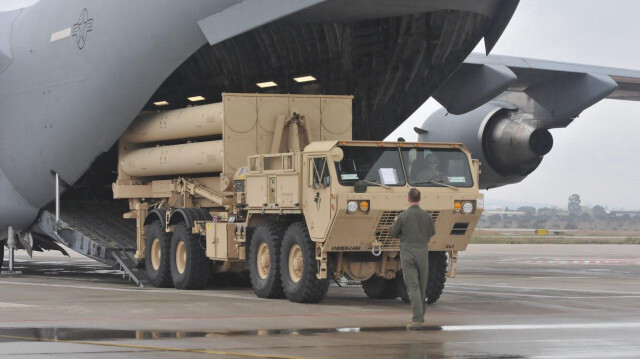
US to deploy THAAD missile defense system in Israel, to be operational against ballistic and hypersonic missiles
Following the Pentagon's decision to send a Terminal High Altitude Area Defense (THAAD) battery and military personnel to Israel amid rising tensions with Iran, the technical capabilities of the system have drawn considerable attention.
Anadolu has compiled details of the THAAD system, a highly regarded air defense technology designed to intercept ballistic missiles that travel within and outside the Earth's atmosphere. The US plans to deploy it in Israel to counter threats from Iran, Houthi rebels in Yemen, and the Hezbollah group in Lebanon.
Currently, Israel employs three air defense systems — the long-range Arrow, medium-range David's Sling, and short-range Iron Dome. However, these systems have struggled to intercept certain types of missiles during recent Iranian retaliatory attacks.
These air defense systems typically include radars and satellite sensors to detect incoming munitions, interceptor missiles to destroy them mid-air, and command centers to manage and coordinate these operations.
On Oct. 12, Israeli Army Radio announced that the US had deployed the THAAD system in Israel to guard against possible Iranian missile strikes. The Pentagon confirmed this, stating that at the direction of President Joe Biden, a THAAD battery and accompanying personnel would bolster Israel following Iran's unprecedented attacks on April 13 and Oct. 1.
- THAAD system overview
THAAD, manufactured by US defense company Lockheed Martin, is a high-altitude air defense system that intercepts ballistic missiles within and beyond the atmosphere. The system excels in providing high-altitude protection, integrates seamlessly with other Western and Israeli air defense systems, and boasts long-range target detection radar.
THAAD is described as having highly effective against short- and medium-range ballistic missiles and has limited capabilities against long-range ones. It employs kinetic hit-to-kill technology, destroying targets without explosive warheads by colliding with them at extremely high speeds.
While effective in the terminal phase, when an incoming munition has the highest speed, THAAD can neutralize missiles even when they are in orbit outside the atmosphere. Each THAAD battery, designed for maneuverability, consists of five primary components: interceptors, launchers, radar, a fire control unit, and support equipment.
Each battery is operated by up to 100 personnel and includes a launch unit mounted on six vehicles, each capable of carrying eight launchers and 48 interceptors, along with radar and communication equipment. The AN/TPY-2 radar, essential to the system, operates in the X-band (8-12 GHz) and detects targets at long range. Its modular design allows for easy transport and deployment.
Each interceptor weighs 900 kilograms (roughly one ton) and is 6.17 meters (over 20 feet) long, with a booster measuring 34 centimeters (over 13 inches) in diameter and a warhead measuring 37 centimeters. The missile travels at 2.8 kilometers (1.7 miles) per second — 8.2 times the speed of sound.
The THAAD has a range of 200 kilometers and can destroy targets at altitudes of up to 150 kilometers. It integrates with other US defense systems, such as the patriot and aegis, as well as F-35 fighter jets and naval vessels.
- Global THAAD deployment
In addition to Israel, the THAAD is currently used by the US and United Arab Emirates (UAE), while Saudi Arabia has signed an agreement for future procurement. The US supplied seven batteries under a $1.42 billion agreement in March 2022, with an eighth battery contract signed in April 2022 for $74 million.
The first THAAD agreement between the UAE and the US was signed in 2011, with two batteries operational there. In 2022, these batteries successfully intercepted ballistic missiles targeting oil facilities near the Al-Dhafra Air Base in THAAD's first operational use.
The $15 billion agreement with Saudi Arabia was signed in 2017 for the delivery of seven batteries, with the first delivery scheduled for 2026. In 2024, the country also secured a joint production deal, becoming the second nation after the US to produce THAAD components.
The US military has had the THAAD system stationed in South Korea since 2017 in response to North Korean missile threats. While Japan does not directly deploy THAAD systems, it hosts an AN/TPY-2 radar on its territory.
- Ballistic missiles
Ballistic missiles are categorized by range: short-range (under 1,000 kilometers), medium-range (1,000 to 3,000 kilometers), long-range (3,000 to 5,500 kilometers), and intercontinental (more than 5,500 kilometers). Additional categories, such as tactical and operational ballistic missiles, have also been introduced for munitions under 3,500 kilometers.
Ballistic missiles have three stages: launch, free-flight outside the atmosphere, and terminal re-entry. Early detection during the terminal phase, which lasts less than a minute, requires high-performance missile defense systems, such as the THAAD.
- Iranian missile strikes on Israel
On April 1, after Israel's strike on the Iranian Consulate in Damascus, killing several officials, including high-ranking members of the Islamic Revolutionary Guard Corps, Iran launched a massive retaliation on April 13, using drones, as well as ballistic and cruise missiles.
In subsequent exchanges, Israel continued targeting Hamas, Hezbollah, and Iranian leaders, culminating in Iran's response on Oct. 1, when dozens of ballistic missiles, including the hypersonic "Fettah 1," hit Israel. Hezbollah also reportedly fired several missile types, including the "Kadir 1," "Nur" cruise missiles, and "Katyusha" rockets.

